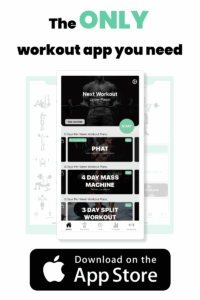Once you learn how to calculate your maximum heart rate for exercise, then you can really dial in what it will take to hit your goals.
Not all heart rate ranges are created equal. What you think might be working could be going against what your goals are. We are going to talk about everything it is going to take for you to determine your maximum heart rate for exercise. No matter what your age is.
Let’s quickly talk about the science behind heart rate ranges. When we say maximum heart rate, we are talking about a theoretical ceiling of where your heart rate can go.
Fortunately, this is just theoretical, and every person is different.
There are set ranges of heart rates that you want to target depending on your goals. And these also depend on your age.
For example, a good traditional cardio range is going to be 70 to 85% of your maximum heart rate. While traditional cardio is good for burning fat, it is not the king of burning fat.
The king of burning fat is HIIT, which is short for high intensity interval training. For HIIT, we want our heart rate to get to 90% of our maximum heart rate.
This is why they call it high intensity interval training. It is INTENSE!
Before we get into formulas and such, I urge you to download our app All Workouts: Personal Trainer (iOS | Google Play). We have 10 built-in, easy to follow HIIT workouts that will absolutely destroy fat. We also have FREE workout plans to build muscle if that is also a goal of yours.
How to calculate your maximum heart rate for exercise
The formula is simple. First we need to subtract your age from 220. So if you are 40 years old, your maximum target heart rate is 180. BOOM! That’s it, you have your maximum heart rate.
Now that you have your maximum heart rate, we can now set some targets to make sure that you are hitting your goals.
Cardio target heart rate
Remember what I said earlier about cardio being 70 – 85% of your maximum heart rate. Let’s now use this to create a formula to find out what heart rate we want to hit to get there:
Minimum cardio heart rate for a 40 year old person: 220 – 40 = 180 (Max heart rate). 180 * .7 = 126.
Now you have your minimum cardio heart rate (70% of your maximum). You want to be hitting at least that.
Maximum cardio heart rate for a 40 year old person: 220 – 40 = 180 (Max heart rate). 180 * .85 = 153.
Now you have your exact cardio range that you want to be in. 126 – 153 BPM. This should be a consistent fat burning tactic if that is what you are looking to do.
HIIT target heart rate
But what if you want more. What if you want to shed fat off of your body? That is where high intensity interval training comes into play. For HIIT, as I mentioned before, you want to get to 90% of your maximum heart rate.
Let’s apply the formula:
HIIT heart rate goal for a 40 year old person: 220 – 40 = 180 (Max heart rate). 180 * .9 = 162
There you have it! If you are 40 years old, and you hit a heart rate of 162, you are officially in the territory of high intensity interval training.
If you are new to HIIT and want to learn more, I wrote an article about beginner HIIT workouts you can do at home. You don’t need any gym equipment. All you need is motivation and the desire to burn fat.
How to monitor your heart rate in real time
The old fashioned way to monitor your heart rate is to check your pulse. This can be done 2 separate ways.
The first way to check is to place your index and middle fingers on your neck or wrist, and count your heart beats for 1 minute. That is your current heart rate. Although I prefer the next way, as I believe it is more accurate for real time data.
The second way is to place your fingers on your neck or wrist, and count your heart beat for 15 seconds. Then multiply that by 4 and you have your beats per minute (BPM).
I find this way more accurate because your heart rate slows as you rest, so counting for a whole minute will surely skew the results.
If you want to skip the old fashioned way altogether, I personally use an Apple Watch. When you put it in workout mode, it is constantly checking your heart rate. All you have to do is look down and see what you are currently at.
Main Point: How to calculate your maximum heart rate for exercise
By now, you understand why it is important to know your maximum heart rate. You can burn fat slow and steady with traditional cardio. If slow and steady is not your thing, you can get maximum results with high intensity interval training.
Maybe you are trying to build muscle and not burn fat. Knowing your maximum heart rate will be useful to you because you probably don’t want to burn calories. Check out our tips on going from thin to muscular.
What are you going to do with this information? Are you going to hit your goals?
There is so much information on the internet now about how to burn fat, lose weight, build muscle, etc… There is no secret or shortcut. It takes dedication and knowledge. Learn to build better exercise habits, and you will be on the path to a better you.
Related Articles
How to Make Exercise a Habit: A Guide
What Does HIIT Workout Mean and Why Should I Care?
4 of the Best High Intensity Interval Training Workouts for Beginners at Home




Leave a Reply